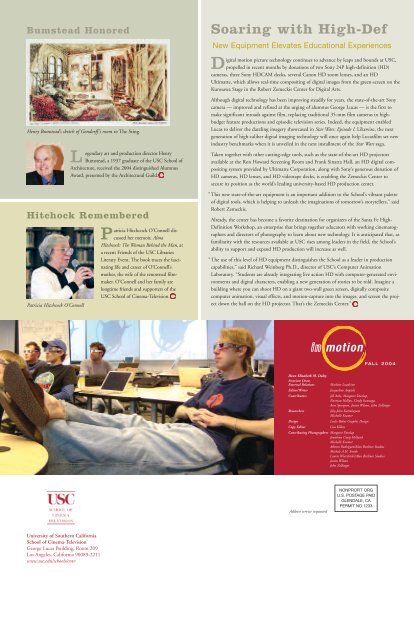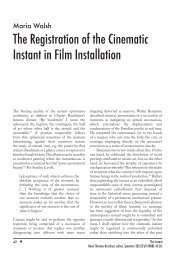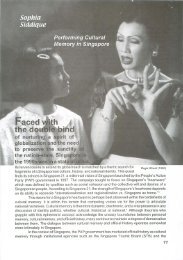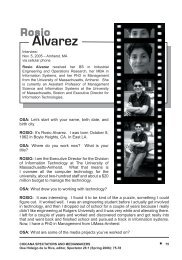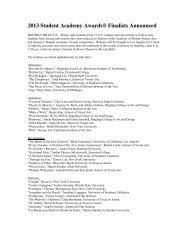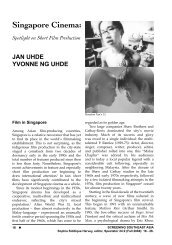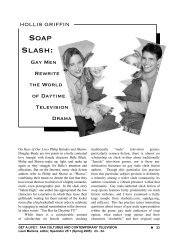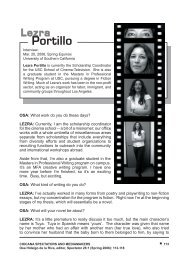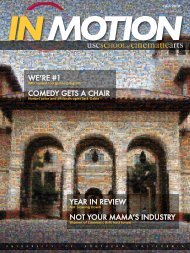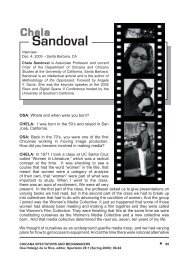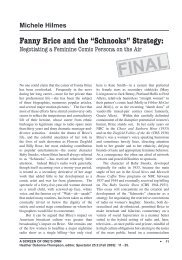IN MOTION (backup) V.3 - USC School of Cinematic Arts - University ...
IN MOTION (backup) V.3 - USC School of Cinematic Arts - University ...
IN MOTION (backup) V.3 - USC School of Cinematic Arts - University ...
Create successful ePaper yourself
Turn your PDF publications into a flip-book with our unique Google optimized e-Paper software.
Bumstead Honored<br />
Henry Bumstead’s sketch <strong>of</strong> Gondorff’s room in The Sting.<br />
L egendary<br />
Hitchock Remembered<br />
Patricia Hitchcock O’Connell<br />
<strong>University</strong> <strong>of</strong> Southern California<br />
<strong>School</strong> <strong>of</strong> Cinema-Television<br />
George Lucas Building, Room 209<br />
Los Angeles, California 90089-2211<br />
www.usc.edu/schools/cntv<br />
art and production director Henry<br />
Bumstead, a 1937 graduate <strong>of</strong> the <strong>USC</strong> <strong>School</strong> <strong>of</strong><br />
Architecture, received the 2004 distinguished Alumnus<br />
Award, presented by the Architectural Guild.<br />
Patricia Hitchcock O’Connell discussed<br />
her memoir, Alma<br />
Hitchcock: The Woman Behind the Man, at<br />
a recent Friends <strong>of</strong> the <strong>USC</strong> Libraries<br />
Literary Event. The book traces the fascinating<br />
life and career <strong>of</strong> O’Connell’s<br />
mother, the wife <strong>of</strong> the renowned filmmaker.<br />
O’Connell and her family are<br />
longtime friends and supporters <strong>of</strong> the<br />
<strong>USC</strong> <strong>School</strong> <strong>of</strong> Cinema-Television.<br />
Soaring with High-Def<br />
New Equipment Elevates Educational Experiences<br />
Digital motion picture technology continues to advance by leaps and bounds at <strong>USC</strong>,<br />
propelled in recent months by donations <strong>of</strong> two Sony 24P high-definition (HD)<br />
cameras, three Sony HDCAM decks, several Canon HD zoom lenses, and an HD<br />
Ultimatte, which allows real-time compositing <strong>of</strong> digital images from the green-screen on the<br />
Kurosawa Stage in the Robert Zemeckis Center for Digital <strong>Arts</strong>.<br />
Although digital technology has been improving steadily for years, the state-<strong>of</strong>-the-art Sony<br />
camera — improved and refined at the urging <strong>of</strong> alumnus George Lucas — is the first to<br />
make significant inroads against film, replacing traditional 35-mm film cameras in highbudget<br />
feature productions and episodic television series. Indeed, the equipment enabled<br />
Lucas to deliver the dazzling imagery showcased in Star Wars: Episode I. Likewise, the next<br />
generation <strong>of</strong> high-caliber digital imaging technology will once again help Lucasfilm set new<br />
industry benchmarks when it is unveiled in the next installment <strong>of</strong> the Star Wars saga.<br />
Taken together with other cutting-edge tools, such as the state-<strong>of</strong>-the-art HD projectors<br />
available at the Ron Howard Screening Room and Frank Sinatra Hall, an HD digital compositing<br />
system provided by Ultimatte Corporation, along with Sony’s generous donation <strong>of</strong><br />
HD cameras, HD lenses, and HD videotape decks, is enabling the Zemeckis Center to<br />
secure its position as the world’s leading university-based HD production center.<br />
“<br />
This new state-<strong>of</strong>-the-art equipment is an important addition to the <strong>School</strong>’s vibrant palette<br />
<strong>of</strong> digital tools, which is helping to unleash the imaginations <strong>of</strong> tomorrow’s storytellers,” said<br />
Robert Zemeckis.<br />
Already, the center has become a favorite destination for organizers <strong>of</strong> the Santa Fe High-<br />
Definition Workshop, an enterprise that brings together educators with working cinematographers<br />
and directors <strong>of</strong> photography to learn about new technology. It is anticipated that, as<br />
familiarity with the resources available at <strong>USC</strong> rises among leaders in the field, the <strong>School</strong>’s<br />
ability to support and expand HD production will increase as well.<br />
“ The use <strong>of</strong> this level <strong>of</strong> HD equipment distinguishes the <strong>School</strong> as a leader in production<br />
capabilities,” said Richard Weinberg Ph.D., director <strong>of</strong> <strong>USC</strong>’s Computer Animation<br />
Laboratory. “Students are already integrating live action HD with computer-generated environments<br />
and digital characters, enabling a new generation <strong>of</strong> stories to be told. Imagine a<br />
building where you can shoot HD on a giant two-wall green screen, digitally composite<br />
computer animation, visual effects, and motion-capture into the images, and screen the project<br />
down the hall on the HD projector. That’s the Zemeckis Center.”<br />
Dean Elizabeth M. Daley<br />
Associate Dean,<br />
External Relations Marlene Loadvine<br />
Editor/Writer Jacqueline Angiuli<br />
FALL 2004<br />
Contributors Jill Aske, Margaret Dunlap,<br />
Norman Hollyn, Cindy Iwanaga,<br />
Ann Spurgeon, Justin Wilson, John Zollinger<br />
Researchers Jiby-John Kattakayam<br />
Michelle Kramer<br />
Design Leslie Baker Graphic Design<br />
Copy Editor Lisa Killen<br />
Contributing Photographers Margaret Dunlap<br />
Jonathon Craig Holland<br />
Michelle Kramer<br />
Alberto Rodriguez/Alan Berliner Studios<br />
Michele A.H. Smith<br />
Laurie Wierzbicki/Alan Berliner Studios<br />
Justin Wilson<br />
John Zollinger<br />
Address service requested<br />
NONPROFIT ORG<br />
U.S. POSTAGE PAID<br />
GLENDALE, CA<br />
PERMIT NO.1233


